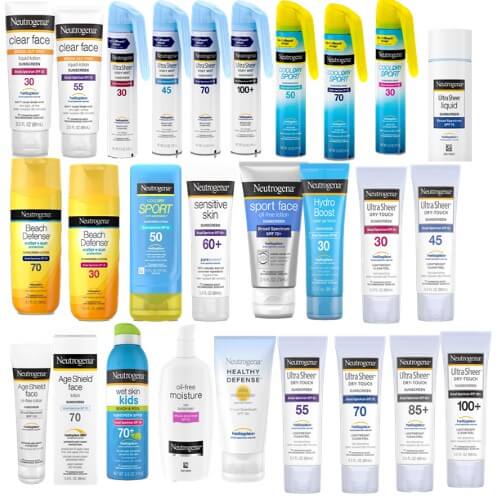See also:
My top sunscreen recommendations
All the mineral sunscreens I have reviewed
Background
In the US there are severe limitations on sunscreen manufacturers and in order to provide UVA protection they can either choose between Zinc Oxide OR Avobenzone.
Neutrogena in their “Helioplex” formulation have chosen the Avobenzone route. Helioplex is synonymous with Neutrogena and my understanding is that it combines:
- UVB filters (Homosalate, Octinoxate, Octocrylene) with
- A UVA filter (Avobenzone – the only UVA1 filter permitted in the US) and
- A UVA and UVB filter (Oxybenzone).
The Avobenzone is stabilised by Octocrylene, high amounts of Oxybenzone and most likely, other (for want of a better word) photostabilisers.
Without any doubt, Neutrogena sunscreens with SPF 30 and above, provide broadspectrum coverage and the presence of Avobenzone, ensures that this includes UVA1 protection.
Despite the above, out of the 39 sunscreens I found (in yes a CVS pharmacy), I’d only be comfortable with 3-4 products. These are:
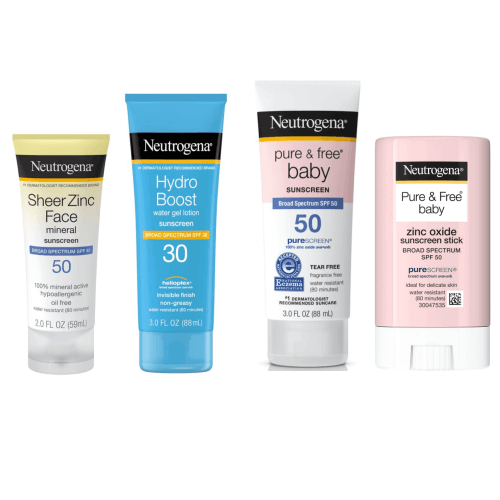
Sunscreens featured are: Zinc Oxide 21.6% group (SheerZinc Face Dry touch sunscreen SPF 50, SheerZinc Dry touch sunscreen SPF 50, pure & free baby sunscreen SPF 50 (liquid and Zinc Oxide formula) and Neutrogena Hydro Boost Water Gel Lotion SPF 30
Most of these sunscreens, are Zinc Oxide 21.6% formulas. (For more details, please read “How to pay the lowest price for your sunscreen,” where I highlight the ubiquity of 21.6% Zinc Oxide formulas).
What’s my beef with Neutrogena sunscreens?
Oxybenzone.
Thirty four out of the 39 sunscreens I analysed, contained Oxybenzone (see Chemicals to Avoid – Benzophenone 3 for more details). BUT I wouldn’t have written this post if it was JUST Oxybenzone that was the problem.
Its this other group of similarly undesirable chemicals that find their way into many Neutrogena sunscreens.
The Undesirable Group
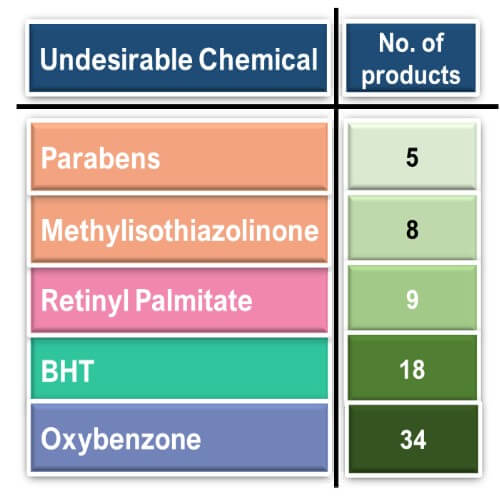
A) Five sunscreens contain Parabens
Parabens are hormonal disruptors that act as estrogen mimickers. (See “Chemicals to avoid – parabens” for more details). Neutrogena gets that consumers don’t want this obnoxious preservative in their product, as the other 34 products don’t have parabens. The paraben culprits are:
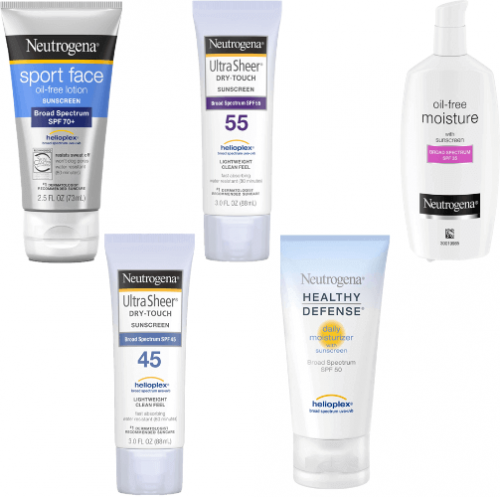
B) Eight sunscreens contain Methylisothiazolinone (“MI”)
MI is a preservative that the EU does not permit in leave on products such as sunscreens because its a contact allergen (see Note 1 below). In the US, MI is a preservative that is allowed in sunscreens, but this is under review. (See Note 2 below).
It’s also been named Allergen of the Year by the American Contact Dermatitis Society.
The MI culprits are:
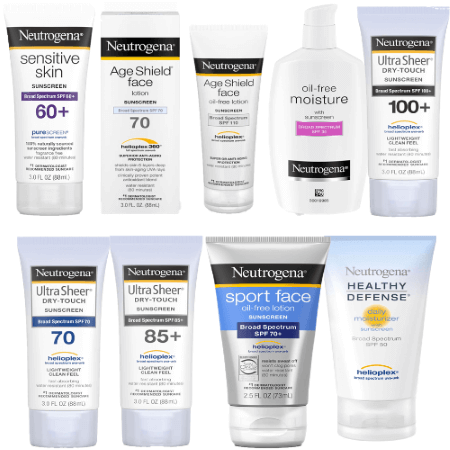
C) Eighteen sunscreens contain BHT
BHA and BHT can induce allergic reactions in the skin and some evidence, suggests that high doses of BHT may mimic estrogen resulting in adverse reproductive affects. (See Note 3 below).
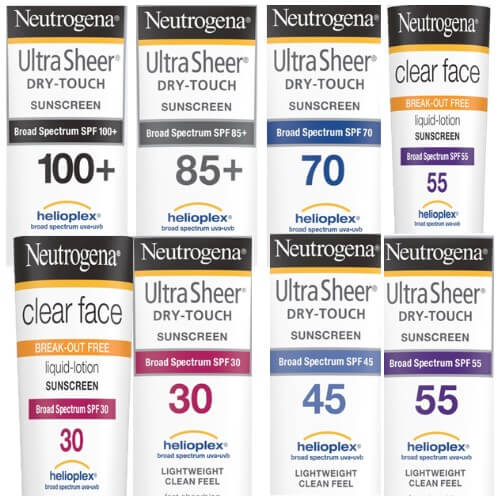
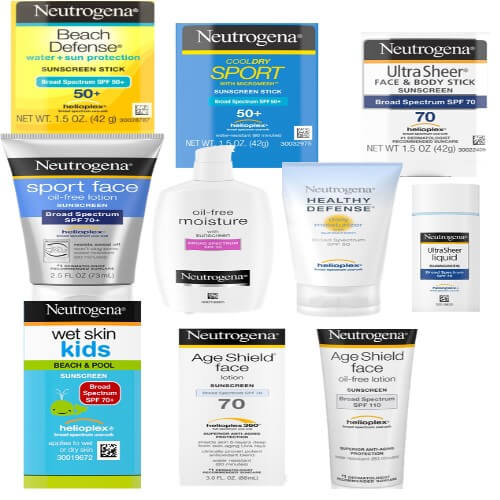
D) Nine products also contain Retinyl Palmitate
RP is a Vitamin A compound, that has does not show significant anti-aging activity.
There is a raging debate about the risk vs. utility of RP. The concern is that topical applications of creams containing RP followed by UVR exposure can increase the risk of cancer. This study (by the National Toxicology Program) has been attacked from all quarters, including the unsuitability of the subject matter: hairless mice. I digress.
My guiding influence is (generally) the EU, that has said its OK with RP in topical applications but then quite sneakily says something like this:
“Retinyl Palmitate is not used in sunscreens and we have not considered its effect there.”
My position is this: the utility of RP is minimal and while scientists decide whether there is risk or not, I am not going to use it.
The RP semi-culprits are:
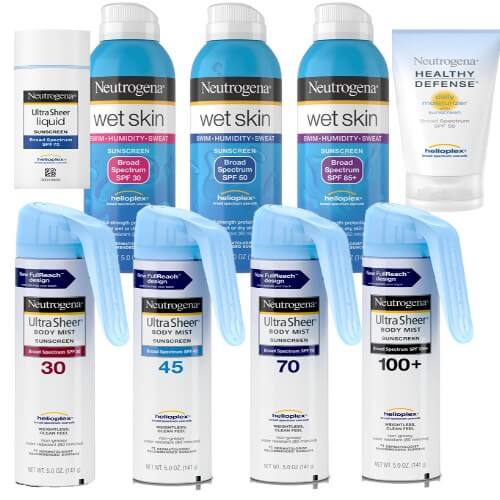
E) Thirty four products contain Oxybenzone
Oxybenzone is a broadspectrum filter and is absolutely key to Neutrogena’s Helioplex formulation. The problems with Oxybenzone are well-documented (see also Chemicals to Avoid: Benzophenone-3).
Today, I wanted to highlight what the FDA’s current thinking on Oxybenzone is. The US FDA (February 2019) says that it needs more data about the safety of Oxybenzone (along with 12 other UV filters). It also said:
In biomonitoring studies of pregnant and lactating women, Oxybenzone has been detected in breast milk, amniotic fluid, and urine samples.
High levels of Oxybenzone in the urine of mothers have been associated with:
(1) Decreased birth weight in girls and
(2) increased birth weight and head circumference in boys, both of which can be indications of endocrine effects
It is estimated that Oxybenzone (from all sources – not just sunscreen) is present in the urine of 97% of Americans [4]
Sunscreen Drug Products for Over-the-Counter Human Use, A Proposed Rule by the Food and Drug Administration on 02/26/2019
If the above quote is insufficient to put the fear of using Oxybenzone in you, I am afraid you are on your own.
The products containing just OXB that haven’t been mentioned before are:

That’s it for this week. Drop me a line if you have any queries or suggestions. ALWAYS happy to help.
P.S. Thank you Neutrogena for your excellent images available at this website Neutrogena
P.P.S. All data is accurate at 17th September 2019. I do not plan to review any of these products in the future, unless Neutrogena rethinks its strategy and uses anything but Helioplex in the bulk of its sunscreens.
